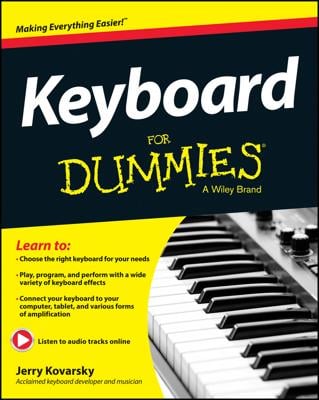So, you’ve made the decision to buy a digital keyboard rather than a piano. Now you must decide what type of digital keyboard you want. Any digital keyboard is a versatile instrument, giving you access to a range of sounds and sound effects. Instead of being limited to the sound of a piano, you can have literally hundreds or even thousands of different sounds at your fingertips.
The number of sounds you can use depends on the type of keyboard you select. Just like computers, digital keyboards have memory, storage space, and performance limitations. Some you can add memory and sounds to, but some are what they are and no more.
Sorting out all the different keyboard types and styles can leave your mind numb, but they all share some common features:
All digital keyboards use sampled sounds, which vary in quality.
You can choose from a variety of keyboard actions, or touch sensitivity — everything from nonresponsive action to weighted-action keyboards designed to mimic the touch and feel of an acoustic piano.
The three common keyboard sizes are standard 61-key, 76-key, and 88-key.
Some degree of portability.
Nearly all models come with a music rack, a plug-in sustain pedal, and MIDI and/or USB connection capability.
Don’t assume that you’ve necessarily gone the cheaper route by selecting a digital keyboard as your instrument of choice. These instruments can be quite expensive, sometimes costing more than an acoustic piano. But they’re also very versatile.
Digital pianos and organs
Digital piano and organ models are either portable or upright or grand. Not surprisingly, the portables are more portable than the uprights and grands, which are designed after their acoustic sisters and are meant to occupy a relatively permanent spot in your home. Both types come with built-in speakers, although the speakers are smaller on the portable models. Both types of digital piano and organ usually, but not always, offer a few sound options like acoustic piano, electric piano, organ, and maybe vibes. They come with a music rack, a stand (if it’s not already a part of the keyboard), and a plug-in pedal.
If you’re looking exclusively for a digital organ, some very attractive models come with dual-manuals and multiple organ effects like draw bars and rotary sound.
Arrangers
If you’re looking to have lots of fun with different sounds and accompaniment features and you’re not concerned with finding the best acoustic piano samples, an arranger is the digital keyboard for you. This type is loaded with “one-man band” features, like scads of sounds (500 or more); automatic drum, bass, and chord accompaniment; and recording and playback. Lower-end models are quite inexpensive and very portable.
Stage pianos
These keyboards, made for onstage performing, offer professional keyboard sounds. If you’re going to be the keyboard player in a band, or even a solo act, and will be gigging around town, the stage piano may be the choice for you. It doesn’t have built-in speakers, so you need to have an external amplifier and speaker to hear yourself play, but you can plug in headphones. Also, a stage piano doesn’t have as many functions as an arranger. Stage pianos come with a music rack and sustain pedal, but you need to purchase a keyboard stand and other accessories separately.
Workstations
Essentially a computer built into a keyboard, a workstation has everything: top-of-the-line sound samples, sequencing, recording and editing, and computer integration. Workstations come in 61-, 73-, and 88-key models. These babies can be quite expensive, but if you’ve got big musical dreams, you may want to try one out.
Synthesizers
You can still buy a good ol’ synthesizer and manipulate waveforms, filters, and work with both analog and digital sounds. Today’s synthesizers come with more sounds to work with than older models, letting you go to town with some good preset sounds.

